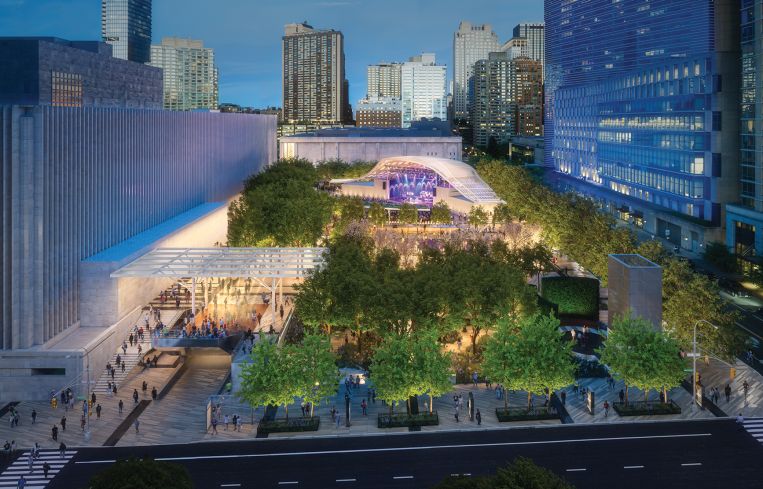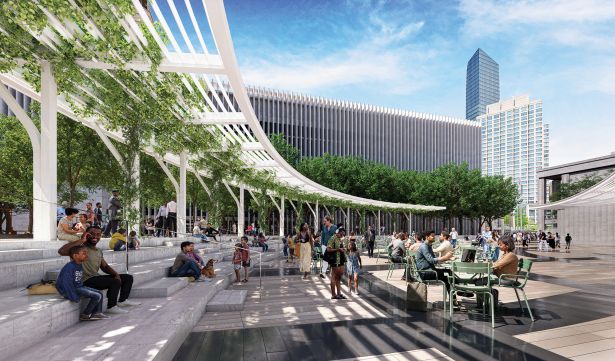Lincoln Center Park Redevelopment Welcomes the Neighborhood
These architects and designers are behind the performing arts center's plans to open itself up more to its West Side neighbors
By Aaron Short August 11, 2025 7:00 am
reprints
Lori Nadeau noticed that her preschoolers sometimes wandered across Amsterdam Avenue to hang out at Lincoln Center with their families once they left her Head Start program at Amsterdam Houses for the day.
So, when Lincoln Center reps visited Amsterdam Houses several months ago to hear feedback about their $335 million plan to redesign Damrosch Park, a 2.4-acre plaza abutting Amsterdam Avenue and West 62nd Street, and its outdoor bandshell, Nadeau was eager to discuss making the complex more accessible to the neighborhood.
“What I’ve seen looks great,” the Hudson Guild Early Childhood Center teacher said. “We go to Lincoln Center to use the fountain and the library, but we have to go all the way around to the side entrance on 65th Street. Once they open it up, we’ll have straight access to it and it will be beautiful.”
Since its decade-long construction and completion in 1969, Lincoln Center has become one of the world’s premier performing arts destinations.
Some 4.2 million visitors traipsed through the 16-acre campus’ 30 indoor and outdoor stages last year, whether to attend red carpet galas at the New York City Ballet or sit on the edge of the Revson Fountain. The annual visitor volume was 6 million before the pandemic, which shut down live performances for more than a year, scrambling the budgets of the hub’s 11 arts organizations and keeping crowds away.
In order to lure people back, Lincoln Center executives launched an innovative free and pay-what-you-can summer arts festival, “Summer for the City,” in 2022 that drew international pop acts, all-day interactive arts exhibits, social dance sessions and the popular Mostly Mozart concert series. They also accelerated the $550 million renovation of David Geffen Hall, which reopened to the public in 2022.
Audiences have returned to Lincoln Center in force but its palatial grounds have long felt inaccessible to many Upper West Side neighbors who have not seen their culture reflected in its programming or who were priced out of its shows. Lincoln Center is also still grappling with the demolition 70 years ago of 18 city blocks and displacement of thousands of residents from the enclave known as San Juan Hill in order to build the campus.
There’s no way to redress the long-term upheaval of the neighborhood, but the possibility of turning Damrosch Park into a year-round performance space while also making it more appealing for residents of all ages to congregate was intriguing.
After conducting a series of participatory planning sessions with urban planning nonprofit Hester Street and NAADA, an urban design firm, in 2023, Lincoln Center announced its architecture team of WEISS/MANFREDI, which would be responsible for designing a new bandshell; Hood Design Studio, which would redesign the park’s landscape; and Moody Nolan, the architect of record.

So far, Lincoln Center has raised about two-thirds of the money needed for the project, including a $75 million grant from the Stavros Niarchos Foundation, $15.73 million from the city, and $10 million from the state. Construction is supposed to start next spring and finish by 2028.
“Our goal is to bring the joy of performing arts to all visitors who come to Lincoln Center, and activating the outdoors is part of that,” Mariko Silver, president and CEO of Lincoln Center, told Commercial Observer. “For some people it has felt forbidding and grand, grander than they might feel comfortable with, but we want to make sure the campus feels in every dimension like an invitation.”
When Lincoln Center officials approached community members for suggestions, they heard a desire for more green space and shade, outdoor programing and cooling water features.
But the most significant critique was increasing access for residents from the far West Side. So Lincoln Center leaders decided to remove the wall along Amsterdam Avenue and create more welcoming entrances.
“The heart of the project is the park, but we are thinking about the whole approach along Amsterdam Avenue,” Silver said. “On that corner you have multiple schools and two libraries, and you’ll see this incredible release of energy. Kids love to come over here and we want them to be here and use this space.”
Much of the landscape’s redesign would be a challenge. The park’s concrete floors are cracked and broken and can heat up like a microwave on sunny summer days. It sits above a parking garage, and water leaks into the underground structure when it rains.
“It’s a very constrained site,” Paul Peters, a principal at Hood Design Studio, said. “We’re creating an unstructured landscape on top of a building and trying to find a way to enmesh Lincoln Center with the rest of the city. We have to make sure we have space for everyone.”
Removing the wall will be the easy part, but the park sits at an elevation that is not a simple fix to make handicap accessible.
The famed Oakland-based landscape design studio plans to add a path that gently slopes upward through a series of groves, which will include a mix of blue perennial flowers, azaleas and rhododendrons, and a rock garden that references the geological history of the site. Hood will also add about 50 new trees to create a larger canopy of shade throughout the park as well as benches and lighting.
But the most exciting addition will be a 150-by-50-foot water feature near the center of the park, which has the potential to change the way people use Lincoln Center. The water can be programmed to release a gentle mist that cools visitors on a hot day.
Peters insists it won’t be a splash pad that will soak theatergoers’ gowns.
“We don’t want to have jets,” he said. “It will feel more like an artistic element to engage in. Imagine sitting on the edge of it, every 30 minutes or hour and there is a kind of release that happens.”
Hood hopes to meet the community’s diverse needs by creating different-sized spaces for people to reflect and socialize, from intimate alcoves to expansive lawns, and adding seating to areas where they already congregate, such as the areas between the columns on 65th Street.
“We’re trying to bring all these different scales and dynamic spaces together in a fairly small space,” Peters said. “You really don’t know how people will use the space and it’s a wonderful thing to see in real life.”
Of course it wouldn’t be Lincoln Center without a world-class stage on the site. The aging Guggenheim bandshell on the westernmost edge of the park is currently inadequate for programming, forcing Lincoln Center to erect a temporary stage each summer season and dismantle it afterward.
That’s where WEISS/MANFREDI comes in. The Manhattan firm is scrapping the existing bandshell along Amsterdam Avenue and replacing it with a boomerang-shaped amphitheater on the eastern side that will remain open throughout the year. They are also shrinking the space between the stage and the back row of the theater nearly in half, from 160 feet to 88 feet. And they are extending the theater’s roof to provide additional protection from the elements while enabling the park to stay open to the public during Lincoln Center performances.

“We’re extending the shade where trees cannot grow,” Marion Weiss, co-founder of WEISS/MANFREDI said. “That sense of being under this shaded ribbon is a shared experience for the performers and the audience.”
Weiss and her co-founder, Michael Manfredi, believe that reorienting the concave stage to a diagonal will improve acoustics and welcome theatergoers from the campus’ western edge.
“You can move from Amsterdam literally up into the park and into the theater that now faces the community,” Manfredi said. “We’re creating a much more intimate audience area if you listen to a performance outside.”
Both were inspired by Lincoln Center’s “Summer for the City” series, particularly its free-form dance sessions under a giant disco ball, and hoped to bring some of that magic to Damrosch Park in the future.
“We saw lines around the block and saw joyous engagement between performers and audience,” Weiss said. “It’s very special — you’ve never felt anything like it until you’re there.”


